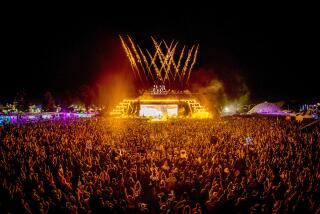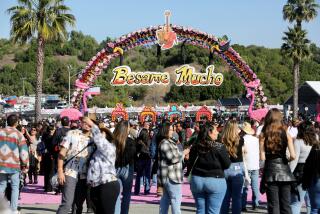Miami’s cultural transformation
It’s Saturday night, and though a drizzle threatens, the lawn is jammed with children snoozing in strollers, couples sprawling on picnic blankets, teens taking a break from skateboarding. The star appears — not some retread boomer rocker but high-octane conductor Michael Tilson Thomas, affiliated with in London and San Francisco, and Miami’s New World Symphony, a prestigious youth development academy.
Make that MTT (as he’s widely known) by way of outdoor Wallcasts — a high-definition projection of the concert inside Miami Beach’s Frank Gehry-designed New World Symphony academy and performance hall, with sound so clear that many who can easily afford tickets inside prefer to listen outside and soak up the “Sunday in the Park with George” vibe.
A smartly dressed couple in their 30s are among those perched on a wall, umbrella close at hand. “This is a unique experience in the world,’’ Jorge Mejia says. He and his fiancée, Amanda, are frequent Wallcasts attendees, he says. “Miami as a city is really coming up.’’
Given the international buzz that surrounded the New World Center’s opening last year, it’s no surprise that locals and visitors alike have come off the sand and out of the nightclubs for a dip into culture. But it’s no quick swim.
Into theater? A dozen regional companies regularly take the stage, from the Summer Shorts festival of one-act plays each June to the latest production by “Brother/Sister Plays” trilogy playwright — and Miamian — Tarell Alvin McCraney.
Dance enthusiast? Edward Villella’s Miami City Ballet, which played to sellout crowds during a recent Paris tour, is just one of the resident companies. (Although he’s announced his retirement, that doesn’t take place for two more years.)
Film buff? Festivals are dedicated to shorts and indies.
Literary fan? November’s Miami Book Fair International, one of the country’s largest consumer book events, has featured top authors such as Ann Patchett, Nora Ephron, Jonathan Franzen and Salman Rushdie as well as Miamians Dave Barry, Edwidge Danticat and Carl Hiaasen.
Twenty-five years ago, the art savvy dubbed Miami “a cultural wasteland,’’ recalls Lin Arison, widow of Carnival Cruise Lines founder Ted Arison. In the early 1980s, the Arisons launched a national recognition program, now known as Young Arts, designed to search out top high school artists in dance, music and visual arts. The New World Symphony, which provides two-year training fellowships for top graduates of U.S. music conservatories, grew out of that program.
One thing slowly led to another. After nearly two decades of effort, the city opened the Adrienne Arsht Center for the Performing Arts, where a single weekend last winter brought performances by Whoopi Goldberg, Brazil’s Balé Folclórico da Bahia, Michael Bolton, Drumline Live, Joshua Bell and a free family fest. In the last 15 months, two additional performing arts centers have opened, one in the county’s northern reaches in Aventura, the other in southern Miami-Dade.
“It’s a really fun place,’’ says Arison, who splits time among Miami, Tel Aviv and New York, where she serves on the board of trustees of the Museum of Modern Art. “It’s just like New York. You can’t do everything. You have to pick and choose.’’
Says Nancy Novogrod, editor of Travel + Leisure magazine, “Miami’s reputation has evolved from a tropical retreat to a very forward-thinking and exciting place to see art and to have a contemporary cultural experience.’’
But it’s Miami’s visual arts scene that has become the city’s sweet spot.
A new Herzog & De Meuron-designed home for the Miami Art Museum is under construction downtown — just one of the county’s half-dozen major art museums. Four more museums feature exhibitions arranged by private collectors whose holdings rival those of many museums.
On any second Saturday of the month, the galleries in the downtown industrial warehouse district known as Wynwood have become so packed during open-house evenings that many venues have begun holding VIP openings the day before, and most galleries now open by 2 p.m. for collectors who want to avoid the crowds, says Susan Kelley of Kelley Roy Gallery. By late evening, the street is so thick with art-goers that you can scarcely drive.
Many credit the city’s arts explosion to the influence of the renowned cultural showcase Art Basel. In truth, Miami has long been home to collectors, dancers, authors, musicians, artists and playwrights. But a decade ago, when Europe’s top art fair brought a U.S. offshoot to Miami, the city’s cultural side moved into the spotlight. Arts insiders now argue that the Art Basel Miami Beach offshoot — held the first week each December — has eclipsed its Swiss parent.
“In terms of the art, the fairs are very similar. Art Basel is the world’s leading brand and draws the world’s best galleries,’’ says Miami art insider Marvin Ross Friedman, a frequent visitor at both the Miami and Basel fairs.
What differentiates the events is the overall atmosphere — Miami is more social — and an enormous number of side events scattered throughout the city.
Crowds of museum curators and gallerists start flooding into town just after Thanksgiving. The first of the so-called satellite fairs — unrelated shows featuring works typically less pricey than the modern masters offered at Art Basel Miami Beach — begin setting up around the city.
Private jets carrying top collectors from Europe, Latin America, Asia and across the U.S. arrive for nonstop openings at museums, galleries and private art spaces owned by local collectors but open to the public. Mobile projects — painted Mini Coopers, a horse-drawn Hummer adorned with art — pop up in the streets. Even the Fairchild Tropical Botanic Garden gets into the event, hosting an annual exhibition of outdoor-appropriate works that this year will include Will Ryman’s flower sculptures.
And after it’s over, the buzz remains.
“When you have an opportunity once a year for a week for the most important cultural patrons in the world to come here, it’s impossible not to see that impact,’’ says Dennis Scholl, vice president/arts for the Knight Foundation and in his own right a significant supporter of contemporary arts.
Tony Goldman, a collector and the neighborhood redeveloper partly credited with the renaissance of SoHo, South Beach and Philadelphia, has set his sights on Wynwood, opening restaurants, encouraging galleries and creating Wynwood Walls, an open-air “museum’’ of murals created by world-class street artists in a collaboration with Jeffrey Deitch Projects.
In the fall, Goldman opened the Light Box at Goldman Warehouse as a home for a trio of cutting-edge arts organizations. “I’m the ignition device,” he says. Three of the city’s private museums are located here in a still-transitioning warehouse district.
A dozen blocks up the street, Craig Robbins, a local art collector and real estate developer, has spent years transforming the Miami Design District from a dying trade center into a hub of art, food — some of the city’s top restaurants are here — and retail. Recently, several top luxury retailers (including Hermès and Cartier) announced they were taking space there.
Between the two lies Midtown, a retail-entertainment-residential district that for some young residents has replaced South Beach as the place to live.
Within a mile are the Arsht Center and the construction sites for the new Miami Art Museum and the new Miami Science Museum. Last spring, Malaysian casino giant the Genting Group spent $236 million for nearly 14 acres of waterfront land adjacent to the Arsht Center, with plans to build a futuristic World Resorts Miami that the company hopes will include a casino.
Though casino games currently aren’t allowed outside tribal resorts, the move has set off something of a frenzy among developers and would-be gaming operators that are gobbling up land nearby. Arts leaders are working with Genting designers to ensure that the arts institutions don’t get buried in traffic.
Several hotels have taken on art themes, featuring works by local and international artists and hosting arts events year-round. And in what may be the perfect confluence of the city’s luxury car culture and its infatuation with design, Miami Beach has become a showcase for architectural auto garages. The 1111 Lincoln Road retail center and parking garage designed by Herzog & De Meuron has become as popular a venue for parties as for stashing vehicles. Garages by star architects Zaha Hadid and Enrique Norten are on the way.
On this breezy, fall evening, the drizzle breaks out in a full-scale storm. Those without umbrellas — the teens on skateboards, a 20-ish man on a bicycle — dash for the cover of Gehry’s curvaceous eaves to wait out the rain. The rest of the crowd pops open umbrellas and stuffs the cheese and crackers back into baskets, and the overture plays on.
More to Read
Sign up for The Wild
We’ll help you find the best places to hike, bike and run, as well as the perfect silent spots for meditation and yoga.
You may occasionally receive promotional content from the Los Angeles Times.






